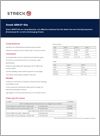Antimicrobial Resistance Detection
Identification of resistance mechanisms is key in controlling the spread of infection
and can help determine the best therapeutic options for patients.
Antibiotic resistance is an increasing threat to global public health. It is responsible for increasing rates of mortality and represents a significant challenge to the NHS.
With the support of genetic identification of resistance mechanisms, infection control and active surveillance play a critical role in preventing the spread of resistance through the population and lowering mortality rates.
Nucleic acid tests supplement the conventional culture susceptibility testing in the identification of theses mechanisms.
Real Time PCR involves extraction of DNA from bacterial cells, amplification of the genetic material and subsequent detection using real-time PCR techniques.
Applications
β-lactamases, enzymes that inactivate the β-lactam family of antibiotics and render them ineffective for treatment of clinically-important Gram-negative bacterial infections, confer resistance to penicillins, cephamycins, and in some cases, carbapenems.
β-lactam-resistant Gram-negative organisms producing multiple or plasmid-mediated β-lactamases are difficult to identify phenotypically and necessitate more specific detection methods to identify clinically important β-lactamases. Genetic identification of these resistance mechanisms is critical for active surveillance and infection control. Because these antibiotics are often selected for the management and prevention of infectious disease, the presence and characteristics of specific β-lactamases play a critical role in selecting the appropriate antibiotic therapy.
The Streck ARM-D® kits are multiplex real-time PCR kits for the detection of clinically-relevant β-lactamase genes including 9 different Carbapenemases, ESBLs and plasmid-mediated ampC gene families.
The Streck ARM-D® Kit, ampC kit targets 6 plasmid-mediated ampC resistance genes and can differentiate plasmid-mediated ampC β-lactamase resistance from chromosomal resistance.
These kits complement phenotypic methods for the detection of multidrug resistant organisms. They can be used with most 4-channel real-time PCR instruments, and have been validated for use with the following systems:
Applied Biosystems 7500 Fast
Applied Biosystems QuantStudio® 7Flex
Bio-Rad® CFX96 Touch™
QIAGEN Rotor-Gene Q
Streck Zulu RT™.
Benefits
Comprehensive list of clinically-relevant β-lactamase target genes (Carbapenemases, ESBLs and plasmid-mediated ampC gene families) that complements phenotypic methods for the detection of multidrug resistant organisms,
Detection and discrimination between plasmid-mediated and chromosomally expressed AmpC β-lactamases,
Improved surveillance and epidemiologic tracking leading to better infection control and increased effectiveness of antibiotic stewardship programs,
Improved management and prevention of infectious diseases – selection of appropriate antibiotic treatment.


